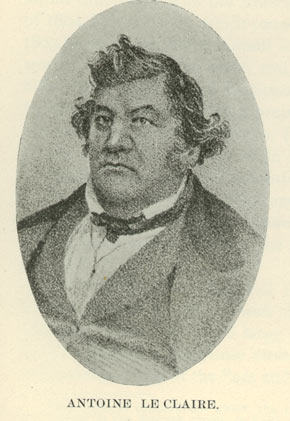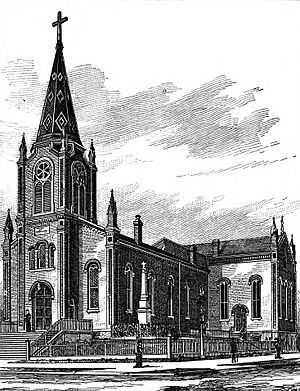Antoine Le Claire facts for kids
Quick facts for kids
Antoine Le Claire
|
|
|---|---|

A portrait of Le Claire derived from an oil painting
|
|
| Born | December 15, 1797 |
| Died | September 25, 1861 (aged 63) |
| Nationality | American |
| Occupation | U.S. Army Interpreter/Merchant |
| Known for | Founding Davenport, Iowa |
| Spouse(s) | Marguerite Lepage |
| Children | Informally adopted nephew Louis Le Claire |
| Parent(s) | François LeClaire |
| Signature | |
Antoine Le Claire (born December 15, 1797 – died September 25, 1861) was an important person in early American history. He worked as an Army interpreter, helping people understand each other. He also owned a lot of land and was a successful businessman. Antoine Le Claire was known for being a very generous person. He is especially remembered as the main founder of Davenport, Iowa.
Contents
Antoine Le Claire's Life Story
Growing Up and Early Career
Antoine Le Claire was born on December 15, 1797. This was in an area that is now St. Joseph, Michigan. Back then, it was called the Northwest Territory. His father, François Le Claire, was French Canadian. His mother was a Native American woman from the Potawatomi tribe.
Antoine's father had a trading post in Milwaukee, Wisconsin. He traded with many Native American tribes there. During the War of 1812, his father supported the United States. Even so, he was captured and held as a prisoner. While his father was imprisoned, Antoine met General William Clark. Clark was impressed with Antoine's skill with languages. He sent Antoine to school to learn proper English.
Antoine could speak English, French, Spanish, and many Native American languages. He started working for the government. In 1818, he became an interpreter at Fort Armstrong (Illinois). He helped Colonel George Davenport communicate. In 1820, Antoine married Marguerite LePage in Peoria. Marguerite was also part French Canadian and part Sac. Her grandfather was a Sac chief named Acoqua. In 1827, the Le Claires moved back to Fort Armstrong.
Becoming a Landowner
In 1832, the Black Hawk War ended. Antoine Le Claire was an interpreter at the peace treaty signing. The United States government bought land from the Sac and Meskwaki tribes. Because Antoine was respected by the Native Americans, he and his wife were given three pieces of land.
One piece of land was on the west side of the Mississippi River. Another piece was given to Marguerite by Keokuk (Sauk leader), a Sac chief. This land was where a Mesquakie village had been. Keokuk said Antoine had to build a house there, or he would lose the land. After the treaty was approved in 1833, Antoine built a house. It became known as the Treaty House. The third piece of land was in Illinois, where Moline, Illinois is today.
In 1833, Antoine became the postmaster and justice of the peace. He was in charge of a large area. He helped solve problems between Native Americans and white settlers. He let people handle things mostly on their own. Settlers liked this approach. In 1834, he started the first ferry service across the river. Antoine also helped Black Hawk (Sauk leader) write his life story by translating for him.
Founding Davenport

On February 23, 1836, George Davenport and other investors met. They wanted to create a new town. It would be on the Iowa side of the Mississippi River. This was across from Stevenson, Illinois (now Rock Island). Antoine Le Claire was part of this group. He owned a lot of land, but not much money. The other investors paid him $1,750 for the land. This land is now a big part of downtown Davenport.
Antoine Le Claire was very important in starting Davenport. However, the town was not named after him. He didn't have enough money to build many buildings. Also, he was part Native American and a strong Catholic. The other investors had English names and more money. George Davenport also wanted a town named after him. So, the town on the Iowa side was named Davenport.
Antoine had the town planned in a grid pattern. There were 36 squares. Three squares were set aside for public use. These were Lafayette Square, Bolivar Square, and Washington Square. The riverfront area was also left open for everyone. Many of the first east-west streets were named after Native American tribes. These names were later changed to numbers. The north-south streets still have their original names.
A Busy Businessman
Antoine Le Claire worked with George Davenport to open the first public house. It was called the Le Claire House. He also started the first foundry in the new town. A foundry is a place where metal is melted and shaped. With A. C. Fulton, he built the first mill.
In the 1850s, Antoine joined other investors. They helped bring the railroad to Davenport. He also owned a sandstone quarry. This quarry was north of the Rock Island Rapids. Stone from his quarry was used for important buildings. These included the Clock Tower on Rock Island Arsenal and buildings at Augustana College (Illinois). It was also used for the supports of the Government Bridge.
Helping the Community
Antoine Le Claire was very generous. When Davenport grew, he set aside land for a Catholic church. In April 1837, he helped start St. Anthony's Catholic Church (Davenport, Iowa). He gave the land for the church to the Bishop of Dubuque. This support helped Davenport become a "See City" in 1881. This meant it would have its own bishop.
When another Catholic church was needed, Antoine donated more land. This was for St. Marguerite's Church. The Le Claires also paid for the rectory and helped build the new church. Antoine also gave land for St. Marguerite's Cemetery. Both St. Anthony's and St. Marguerite's were named to honor the Le Claires' kindness. Antoine also sang in the St. Anthony's choir. He played the bass viol.
Their generosity wasn't just for Catholic churches. Le Claire also gave land for the first First Baptist Church and other churches.
The Le Claires helped society in other ways too. Antoine gave Bolivar Square to Scott County. This helped Davenport become the county seat. In 1846, he donated land for Iowa College. This college later moved and became Grinnell College. In 1855, he built a new house. He gave his old Treaty House to the Mississippi and Missouri Railroad. It became Davenport's first train station. The Le Claires also welcomed Sac and Mesquakie tribes. They could camp on his land for as long as they wished.
Later Years and Passing
Antoine and Marguerite Le Claire did not have their own children. In 1849, Antoine's half-brother Alexis passed away. Antoine and Marguerite then took in Alexis's son, Louis. Antoine even introduced Louis to former President Millard Fillmore as "my boy."
In 1857, many banks in the Midwest faced problems. This was called the Panic of 1857. The Cook and Sargent Bank in Davenport was in danger. Antoine Le Claire told the people of Davenport to stay calm. He said the bank was safe and promised to use his own money to protect it. The bank still failed, but Antoine kept his promise. He paid back the money. This stress might have made him sick.
Antoine Le Claire passed away on September 25, 1861. His funeral was held at St. Marguerite's Church. He was buried in the church yard. Marguerite Le Claire passed away on October 18, 1876. She was buried next to her husband. Later, when Sacred Heart Cathedral was built, their bodies were moved. They were reburied at Mount Calvary Cemetery.
Antoine Le Claire's Legacy
Many places in the Quad Cities area are named after Antoine Le Claire. These include:
- Le Claire, Iowa, a town started on his property
- Le Claire Township, Scott County, Iowa
- LeClaire Hotel, in Moline, Illinois
- LeClaire Park, in Davenport
- LeClaire Street, in Davenport



